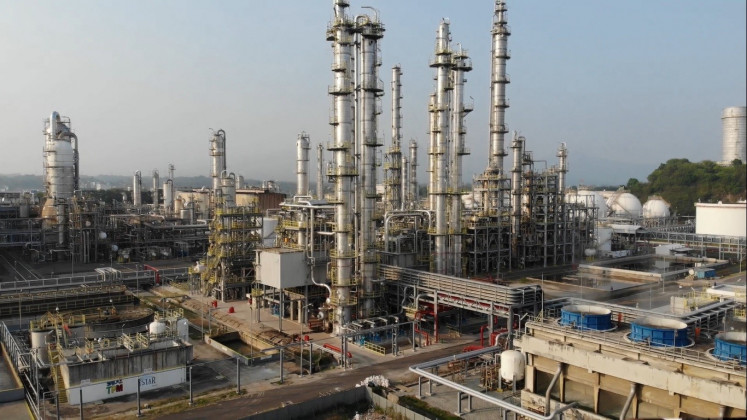Analysis: Coal industry outlook for 2019: Not better than 2018
The performance of Indonesia’s coal sector showed significant improvement in 2018
Change text size
Gift Premium Articles
to Anyone

T
he performance of Indonesia’s coal sector showed significant improvement in 2018. Coal production surged to 548.6 million tons in 2018, 19 percent higher than production volumes in 2017. While 78.2 percent of total Indonesia’s coal production was exported in 2018 the domestic market merely absorbed 21.8 percent of it that year. Both markets experienced positive performance in 2018.
The increase of Indonesia’s coal exports in 2018 was primarily caused by growing demand from major importers, especially China and India. In 2018, these countries took 56 percent in Indonesia’s exported coal, their import volumes growing by 16.3 and 10.1 percent, respectively.
At the same time, other major coal importers such as Japan and South Korea were experiencing a decline in the volumes of coal they imported in 2018. Indonesia’s coal exports to these countries declined by 8.4 and 8.6 percent, respectively, in 2018. In total, Indonesia’s coal export volumes still surged by 10.1 percent in 2018, higher than the 2017 growth when it was only 5.4 percent.
In addition, demand for domestic coal has also kept growing in line with the construction of coal-fired power plants. Although domestic coal sales did not reach the target of 121 million tons set by the government in 2018, coal sales for the domestic market rose by 18.6 percent, an increase from 97 million tons in 2017 to 115 million tons in 2018.
The growth of domestic coal sales in 2018 was greater than in 2017, when it only grew by 7.2 percent. This significant growth was caused by an increase of electricity sector consumption. State-owned electricity company PLN reported that coal consumption for the electricity sector in 2018 improved by 19.9 percent from 76 million tons to 91.1 million tons.
Going forward, we predict the performance of Indonesia’s coal sector will be somewhat sluggish in 2019. We expect coal demand from major coal importers will not be as high as in 2017 and 2018. There are few factors for the declining demand from major coal importers, especially China and India.
China’s total coal import quota in 2019 will not be more than its 2018 level. In addition, according to a Bloomberg Intelligence report, China will have a new thermal-coal production capacity in 2019. Approximately 200 million tons of coal capacity is ready to start production in 2019, while another 409 million tons of government-approved capacity is under construction. These factors will possibly diminish import demand from China in the coming year.
In addition, it remains unclear whether India will increase its coal imports in the coming year. Since 2017, India’s government has prioritized the use of its own domestic coal production to supply its electricity sector. Yet, India’s domestic coal production is still not enough to meet the needs of its electricity sector so that India’s coal imports kept increasing in 2018.
Amid this local shortage of coal in India, India’s government has pushed Coal India (India’s state-owned enterprise) to produce more to meet the needs of India’s coal-fired power plants. In 2019, we expect improvements in the country’s local production capacity and in its logistics arrangements so that its coal production will increase.
Currently, Coal India plans to acquire more railway wagons from Indian Railways to transport the coal to power plants over the next five years to increase domestic coal supply. This should help ease transportation bottlenecks and local coal shortages and potentially reduce coal imports in 2019.
Considering current global coal supply and demand, we predict that the Newcastle thermal coal price will be from US$80 to $85 by the end of 2019, lower than at the end of February 2019 when it was $96.10 per ton.
Uncertain conditions in global coal demand involving China and India and lower price expectations in 2019 are also reflected in the behavior of publicly listed coal companies in Indonesia. Almost all of Indonesia’s coal producers tend to hold to their production targets and their capex this year. This story is very different from in 2018 when almost all producers were still certain of coal demand from major coal importers so that they kept ramping up their production and their capex.
In order to overcome the uncertainty of the global coal market, especially involving China and India, we suggest Indonesia’s coal producers look for other potential markets to replace China and India as the main export destinations. In a longer time span, we forecast demand from both countries will decline eventually as their governments try to reduce coal imports and improve their environmental conditions. New export markets for coal will likely come from ASEAN countries as the volume of Indonesia’s coal exports to ASEAN countries keeps increasing. In 2018, Indonesia’s exports to the four biggest ASEAN coal importers (Philippines, Malaysia, Thailand and Vietnam) increased by 23.1 percent.
Furthermore, Indonesia’s coal producers should plan to integrate their chain production from upstream to downstream to decrease the impact of coal price fluctuations.
As an example, coal producers could integrate coal mining with electricity procurement. Indonesia’s electricity demand is very promising and the government has planned to build an immense number of coal-fired power plants to meet this demand.
This revenue from the electricity sector could be a subtitute source of revenue for the companies. Also, Indonesia’s coal producers could innovate to change coal to gas or to fuel oil. This effort would assist the government to reduce dependency on oil and gas imports in the future.
_____________________
The writer is an industry analyst at Bank Mandiri.









